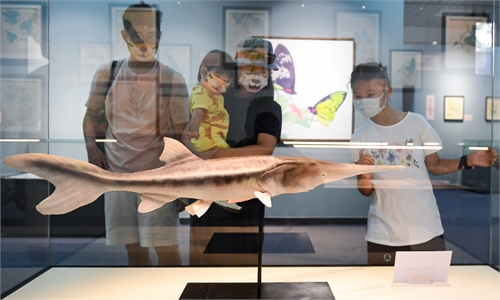Some 100,000 Chinese sturgeons were released from their normal captive breeding environment to the Yangtze River in Yichang, Central China's Hubei Province on Saturday morning in a bid by the China Three Gorges Corporation (CTG) to boost aquatic biodiversity conservation.
In total, some 200,000 Chinese sturgeons will be eventually released into the Yangtze River in three groups over coming days. The released Chinese sturgeons, aged from half years to 14 years old, are second-filial-generation Chinese sturgeons - spawn of the first-generation sturgeons which were grown from harvested eggs that were hatched and fertilized.
The surgeons will swim from Yichang to the middle and lower reaches of the Yangtze River before finally entering the ocean. They will return to the Yangtze again to spawn after ten years.
After forty years and five generations of unremitting technical research, the CTG has overcome a series of core technical challenges including Chinese sturgeon nutritional development regulation, genetic management, sex identification and genome tracking among others, according to the CTG.
So far, the CTG has cultivated the largest artificial population of Chinese sturgeons. These efforts have laid a strong foundation for the sustainable continuation of Chinese sturgeon species.
Jiang Wei, chief engineer of the Chinese sturgeon research institute under CTG, told the Global Times on Saturday that before releasing those Chinese sturgeons, they have marked them in order to track their condition after they return to nature.
Researchers have marked larger Chinese sturgeons that are close to sexual maturity, and will monitor them later through satellite marking to evaluate the distribution of Chinese sturgeons in China's coastal waters and analyze the main environmental factors that affect its survival and activities. These results will provide a scientific basis for the formulation of relevant protection measures.
According to Jiang, the proportion of released Chinese sturgeons successfully entering the ocean has increased greatly over recent years. Initially, only about 30 to 40 percent of Chinese sturgeons could make their way to the open sea, but now the number has increased to 60 to 70 percent, which in large part is due to the country's growing efforts in the Yangtze River ecological protection.
In 2021, China began to enforce the 10-year fishing ban in key waters of the Yangtze River, and in the same year, the Yangtze River Protection Law came into effect.
This was the 68th release of Chinese sturgeons carried out by the CTG since 1984.
About 5.5 million Chinese sturgeons have been released.
Du Hejun, supervisor of Conservation Technology Research Group under the CTG, told the Global Times that they have made several breakthroughs and some firsts in Chinese sturgeons' protection, including using a novel non-invasive method for sex identification in Chinese sturgeons.
Du noted that according to tracking data, the number of male Chinese sturgeons was significantly fewer than female Chinese sturgeons. Therefore, more adult male Chinese sturgeons will be released this time to ensure gender balance.
In Du's research group, they have not only focused on the protection of Chinese sturgeons, but also on other rare and endemic fish in the Yangtze River.
According to Du, they also shared the useful experiences in those aquatic animals' protection with scientists in other countries.
More than 100 people from all walks of life and in different age groups from primary school students to the elderly participated in Saturday's event. Many applied to participate in the event through online channel, hoping to contribute to the region's ecological protection.
At the Chinese sturgeons' release site, several foreigners were also present working as volunteers.
Jamil Afzal from Pakistan, a PhD student studying the Hydraulic Engineering at China Three Gorges University, was one of them. He told the Global Times that he released around 20 smaller Chinese sturgeons into the water.
"This ceremony showed Chinese people's love for Chinese sturgeons and nature. This is a very important event for the environment," he said.
Known as the "panda of the water," the Chinese sturgeon is the emblematic species of aquatic life in the Yangtze River. However, overfishing, shipping and pollution in the past put the species on the verge of extinction.
China banned the commercial fishing of Chinese sturgeon in 1983, and in 1988 listed it as a key protected wildlife species at the national level. In 2010, Chinese sturgeon was upgraded to a Critically Endangered status by the International Union for Conservation of Nature.

